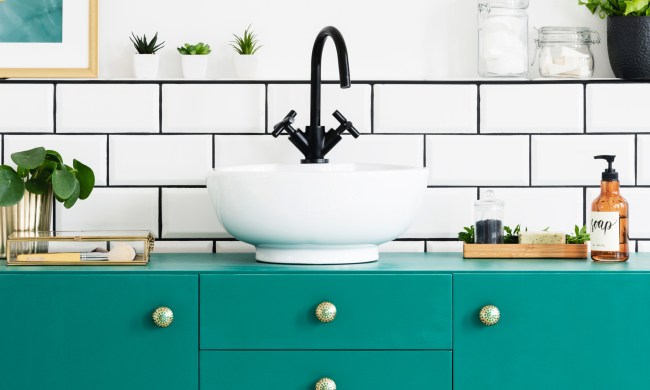Your bathroom is your spa-like sanctuary, a place of peace and serenity — until your eyes fall upon that design flaw you hate or you realize the way your bathroom has been designed makes it completely impractical for everyday use.
We’ve been there — and so has every other homeowner. Some took to the subreddit r/mildlyinfuriating to vent their annoyance; these are the bathroom design flaws that are all too common and how you can fix these design mistakes.

Sinks with no space for soap — or anything else
Sometimes your bathroom is so small that there’s no room for a large vanity (this is especially true in half-baths) which means you might have to sacrifice some countertop space, as redditor mcharb13 did. And while there is room on this counter for a bar of soap, that’s not the preferred choice for everyone — so what can you do?
This is where shelves and hooks are your friends. Invest in a floating shelf near your sink or a wall-mounted caddy — and maybe a hook or two — and now you have plenty of room for your hand soap, your washcloth, and even your makeup bag or shaving tools. (Just leave the toothbrush somewhere else — trust us.)

Holders your toilet paper is too thick for
Have you ever bought new toilet paper and put it on your wall-mounted or recessed toilet-roll holder, only to find out the roll was so thick it wouldn’t spin? While this problem goes away with use, eventually you’ll have to use a new roll — meaning you’re stuck in an endless cycle of fighting with your toilet paper.
If you don’t want to give up your triple-ply toilet paper or that amazing deal you got on the extra-large roll at Costco (we don’t blame you), try investing in a freestanding toilet-roll holder. Your toilet paper will definitely spin no matter how thick the roll, and there are plenty of well-designed freestanding styles that look classy and elegant. (Yes, toilet-roll holders can look classy.) They’re practical too — many have storage options for a few extra rolls of toilet paper, which can free up space under your sink or on your shelves.

Improperly laid tiles
No, we’re not necessarily talking about using the wrong grout, crooked tiles, or any of the other signs of a bad tile job; we’re talking about when the person tiling messes up the design. Chevron and similar patterns are gorgeous and can add plenty of dimension and visual interest to a space — but if the pattern gets messed up as it did for redditor 37chickenducks, you’ll find yourself staring at it every time you enter the shower. (Don’t see it? Check out the right side of the drain.)
What to do? If you hired a professional for the job, be sure to communicate with them to fix any mistakes. If you’ve done the job yourself — or recently moved into a home and inherited this issue — the problem is a little harder. While it is possible to remove tiles without breaking them, this will be incredibly difficult if they’re firmly attached. If you want to give it a try:
- Remove the grout.
- Position a chisel in the grout line so it’s under the tile.
- Use a hammer to tap it gently to see if the tile comes loose (this does come with the risk of chipping or cracking the adjoining tile).
- If the tile doesn’t come loose, use a thin, flexible putty knife to try to accomplish the task.
And if that doesn’t work (or you don’t want to risk it)? Invest in a shower mat.
Of course, the easiest way to fix this issue is to avoid it entirely. So whether you’re tiling the bathroom yourself or hiring someone to do it, be sure to check and double-check everything (and carefully vet your contractors and their previous work before you hire them).
Sure, these design flaws may just be mildly infuriating, but that doesn’t mean homeowners have to live with them. You want your bathroom to be practical, functional, and gorgeous, so there’s no reason to live with any issue that’s going to irritate you every time you step into the room.



